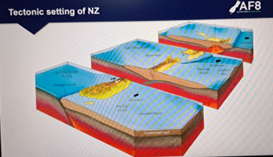Geoscience Society Webinar Recap: Planning for future Alpine Fault earthquakes
On Friday, 17 November 2023, the AusIMM Geoscience Society hosted the webinar “Planning for future Alpine Fault earthquakes” as presented by Prof. Caroline Orchiston of the University of Otago, New Zealand.
The outline of New Zealand’s major subduction plate boundary faults introduced the South Alpine fault that runs onshore, subparallel to the west coast of the South Island. The geological research has a number of projects, including a focus on defining the position and impact of the larger scale faults (above 7). Innovate research into recent sediments triggered by earthquakes were studied to indicate a regular pattern of earthquake history, being about every 300 years going back some 5,000 years (now at 70% likelihood of big fault movement).
The impact of these large earthquakes has on remote communities and the nation’s infrastructure (road / rail displacement, landslides, tsunamis, liquefaction etc) was mapped, and supports the nation’s Civil Defense program [“AF8” = Alpine Fault scale 8]. The impact of this work has been taken up in adjustments to building codes [“Quake Core” – earthquake engineering], port infrastructure, road design, power & water distribution etc, that leads into the design of emergency response programs. Socialization continues on an annual bases with each district’s local government & emergency response teams [“Shake Out” training], along with programs at schools and the general community.
The Geoscience Society committee would like to extend our thanks to Dr Orchiston, all those that have been involved in the AF8 project, for an insightful and engaging presentation.
The following captures some of Q&A from this talk:
- There are discussions relating to earthquake warning systems – particularly on challenges to what sort of guidance could or should be provided to people with short warning times (which could be as short as 30 sec).
- Mapping the underwater extension of the fault [NEMO] is difficult with rough seas, and declining public budgets. Note that tsunamis from this fault can reach the east coast of Australia.
- A positive and key outcome of the AF8 program is the heightened awareness and popular acceptance of students to the nature of earthquakes, and that teachers are now building more of this into the school’s curriculum.
- Similar to concerns in Australia, there are local concerns that not enough students are taking up geoscience, though there is good interest in the social impact sector such as the community risk management, civil design etc.
You can watch the webinar recording on the AusIMM Digital Library here.
